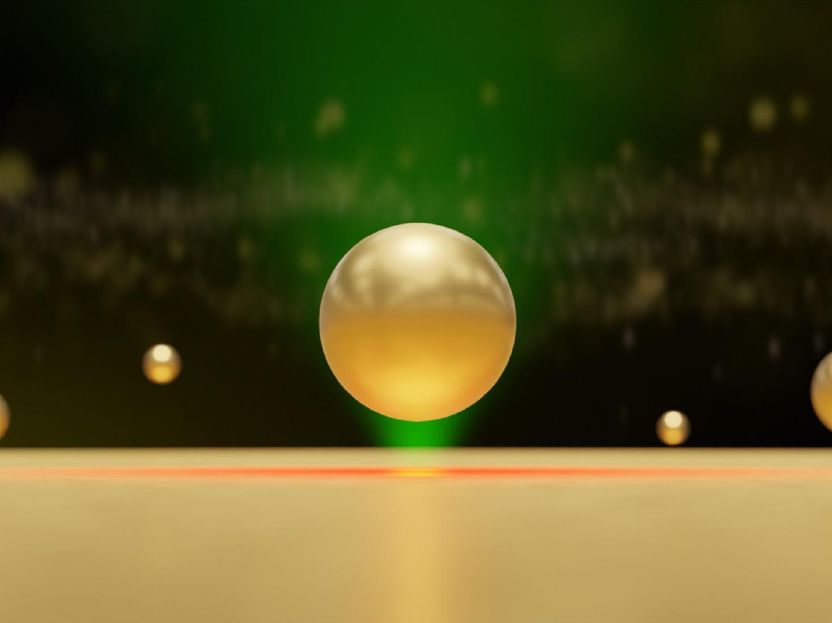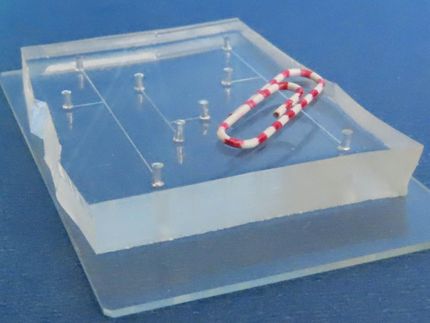Scientists develop new thermofluidic process for lab-on-a-chip applications
This will unlock groundbreaking solutions for nanotechnology, the manipulation of liquids in systems in tiny spaces, or in the field of diagnostics
Researchers at Leipzig University have succeeded in moving tiny amounts of liquid at will by remotely heating water over a metal film with a laser. The currents generated in this way can be used to manipulate and even capture tiny objects. This will unlock groundbreaking new solutions for nanotechnology, the manipulation of liquids in systems in tiny spaces, or in the field of diagnostics, by making it possible to detect the smallest concentrations of substances with new types of sensor systems. In an article recently published in “Nature Communications”, is described how this was achieved.

Illustration of a gold nanoparticle trapped near a locally heated gold surface by hydrodynamic and van der Waals forces.
Martin Fränzl, Universität Leipzig
Flow generation is important at all scales – for transporting fluids in pipes, nutrients in blood vessels or chemicals in microfluidic systems for chemical processing and analysis. In almost all of these cases, the flow is the result of a difference in pressure that drives the fluid through these channels. These uncontrolled flows are not very useful when it comes to moving objects in solution, such as in the production of new functional materials, or transporting minute amounts of material to tiny, highly sensitive sensor elements. “They all move objects at the same speed along the vessel walls, and that’s why it is difficult in microfluidics to bring molecules to sensory elements or to assemble objects using these flows,” said Martin Fränzl, who worked on the project as a doctoral researcher.
Martin Fränzl and Professor Frank Cichos have now found that they can generate very strong fluid flows even in the tiniest of channels by heating a very thin metal film on one side of the channel with a focused laser beam. The flows originate in an ultra-thin liquid layer just a few nanometres above the surface of the metal and mix the liquid in the channel with a specific flow pattern. Fränzl measured this flow pattern using nanoparticles as tracers. Not only have the scientists succeeded in exploring the origin of these currents, but they have also shown that they can capture, separate or transport nano-objects by cleverly combining currents and controlling other forces remotely by laser.
“This is fascinating,” said Fränzl, “because it allows us to control how objects and fluids move at the nanoscale without moving the entire fluid in the channels.” Similar approaches are already being used in a project run by the joint Transregio / Collaborative Research Centre 102 at the Martin Luther University Halle-Wittenberg and Leipzig University to study the formation of protein aggregates involved in the development of neurodegenerative diseases.
Both researchers are particularly interested in combining these laser-driven thermofluidics with machine learning techniques in order to create automated smart nanofactories – for nanoscale manufacturing, programmed material manipulation and sensor technologies – that optimise and adapt to new requirements based on the information they collect.
“We believe that thermofluidics will help us develop new technologies and solutions that may be highly useful for new collaborative projects such as the µChem initiative, which combines physics, chemistry, biochemistry and artificial intelligence in microenvironments,” said Professor Detlev Belder from the Institute of Analytical Chemistry at Leipzig University’s Faculty of Chemistry and Mineralogy. This paves the way for lab-on-a-chip applications.
The method was developed in collaboration with b-ACTmatter, the Interfaculty Centre for Bioactive Matter, which is being funded under the federal programme STARK. STARK was set up to promote the transformation process in coal regions. b-ACTmatter aims to develop new materials and technologies that contribute to an innovative, sustainable and circular development of the economy.

















































